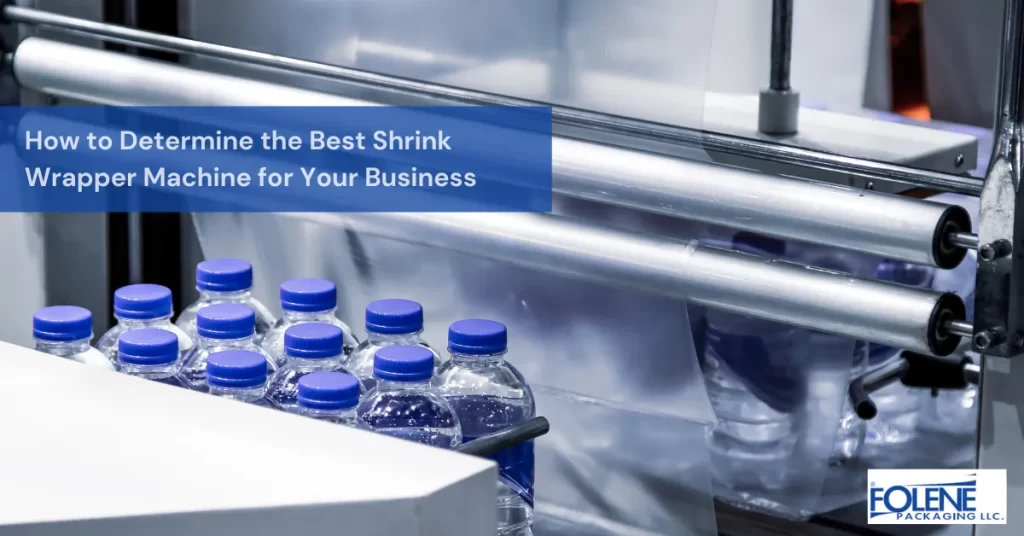
You know how important the right packaging materials are in manufacturing, distributing, and selling your products. But what about the equipment you’re using? Are you using the best shrink wrapper machines for your products, output volume, and shrink materials? Folene Packaging presents a comprehensive guide to determining the best heat shrink machine for your business. Keep reading to see if it’s time for a packaging equipment upgrade.
What is the Shrink Wrapping Process?
Shrink wrapping is a packaging process that uses heat to shrink a plastic film around a single product, multiple products, or pallet of products, protecting the items from contaminants and damage during shipping and storage. Shrink wrapping is commonplace across industries, from food and beverage items to electronic device packaging. While shrink wrapping can be done manually, there are a variety of machines available to make the shrink wrapping process more efficient, reduce waste in the packaging process, and increase output.
Types of Shrink Wrapper Machines
There are several categories of heat shrink machines available in the packaging equipment market. Let’s examine what each type of machine is built to do best.
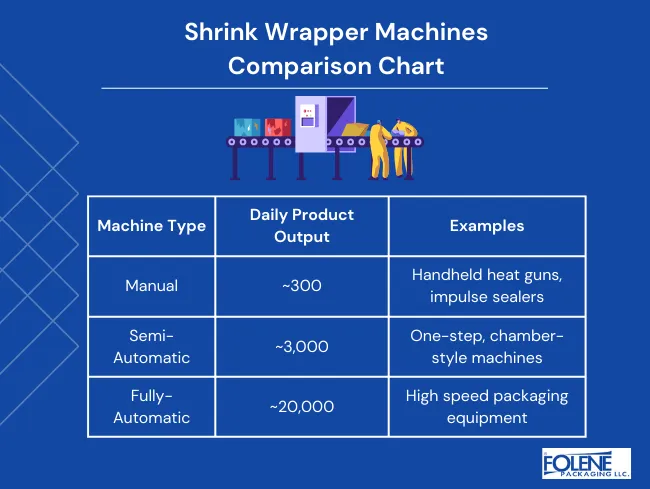
Manual shrink wrap machines:
This category includes handheld heat shrink guns, hand impulse sealers, and manual L-Bar and I-Bar sealers. These manual options are ideal for low-volume packaging operations processing under 300 products daily. These are generally well suited to micro-distributers and beginner e-commerce entrepreneurs, as they are fairly inexpensive and do not require a large investment. These machines require manual input to feed the shrink film into the machine and wrap and seal products.
Semi-automatic shrink wrap machines:
These machines offer a balance between manual and fully automated systems, requiring some manual intervention but increasing efficiency. This category includes one-step and chamber-style heat shrink machines along with other similar equipment. While slightly more expensive than their fully manual counterparts, they automate key repetitive tasks and ensure a higher level of uniformity and packaging efficiency. This enables growing distributors to increase production to around 3000 products per day.
Fully automated shrink wrap machines:
These high-speed machines that can wrap and seal products quickly and efficiently, ideal for high-volume packaging operations. These machines are expensive and require expert periodic maintenance to ensure consistently high performance. However, they can also handle multiple product sizes, types, and ranges, with easily customizable settings. These machines yield ultimate efficiency and production levels, supporting around 20,000 products packaged daily, depending on the specific machine.
L-Bar sealers:
These are great for any type of shrink film, with three sealing bars designed to make sealing centerfold shrink film easy and efficient. These machines are generally available in manual or semi-automatic options.
I-Bar Sealers:
An excellent option for packaging processes that utilize shrink bags or shrink tubing, offering one sealing bar to seal and cut the shrink film in one motion. I-Bar sealers are also usually available as fully manual or semi-automatic machines.
Key Features to Consider When Buying a Shrink Wrap Machine
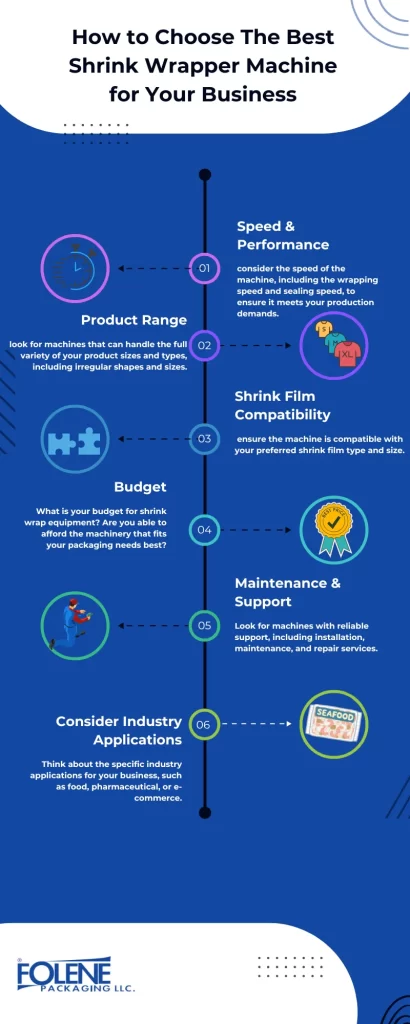
There are several important factors to consider when deciding on the right type of shrink wrap machinery for your packaging operations.
Speed & Performance: consider the speed of the machine, including the wrapping speed and sealing speed, to ensure it meets your production demands.
Product range: look for machines that can handle the full variety of your product sizes and types, including irregular shapes and sizes. Measure the dimensions of the smallest and largest items in your inventory to ensure full coverage for all of your products. Bear in mind future expansion to other product sizes and types.
Shrink film compatibility: ensure the machine is compatible with your preferred shrink film type and size. Always check the product data sheet on the shrink film you are considering to ensure that it is compatible with your shrink wrapper machine. Not sure if it’s compatible? Check with the shrink film manufacturer before using it on your equipment. Do a test run any time you switch to a new grade or gauge of shrink film to ensure product compatibility.
Budget: What is your budget for shrink-wrap equipment? Are you able to afford the machinery that fits your packaging needs best?
Consider industry applications: think about the specific industry applications for your business, such as food, pharmaceutical, or e-commerce. For example, does the packaging process need to take place in a temperature-controlled environment (refrigerated, frozen, etc.)
Regulatory compliance: ensure the machine meets regulatory requirements for your industry.
Support: look for machines with reliable support, including installation, maintenance, and repair services.
These points are essential to revisit periodically as your company and packaging volume grows, to consistently reassess if your current packaging equipment is still well suited to your operations, or if it is time for an upgrade.
4 Key Steps to Successfully Operating and Maintaining Your Shrink Wrap Machine
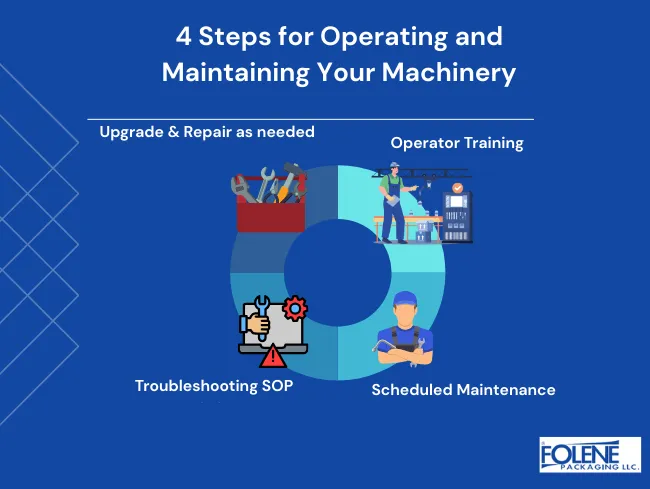
Following these 4 simple yet crucial steps can keep your machine operating at maximum efficiency for the long term, increasing productivity and ROI.
Provide training for operators to ensure they understand how to use the machine safely and efficiently.
Schedule regular maintenance to ensure the machine runs efficiently and effectively.
Prepare a troubleshooting manual to address common issues, such as film breaks or sealing problems. Train shrink wrapper machine operators to follow standard operating procedures to attempt to fix the problem internally before escalating the issue to an external repair team.
Upgrade and repair the machine as needed to maintain performance, quality, and efficiency.
Shrink Wrap Machine Cost and Budgeting
When deciding what type of machinery to purchase, it is crucial to evaluate various financial factors thoroughly. You’ll need to consider the initial investment, which encompasses the purchase price of the machine as well as the installation costs. Additionally, ongoing costs such as maintenance, repair, and replacement parts must be factored into the decision-making process.
It’s essential to weigh the machine’s costs against the cost savings associated with using a shrink-wrap machine, which can include reductions in labor expenses and increases in efficiency. Ultimately, calculating the return on investment and the expected savings will guide manufacturers in making an informed choice about their machinery investments.
Regulatory Compliance for Shrink Wrap Machines
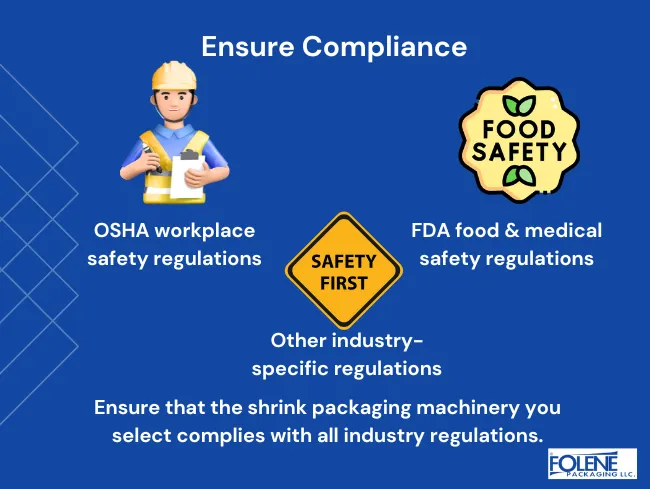
Packaging in certain industries, such as food, beverage, medical, and pharmaceutical, among others, requires additional attention to packaging regulations and compliance. Ensure that your packaging equipment and materials meet all relevant regulatory body standards to avoid compliance issues, fines, and product recalls.
FDA regulations: ensure the machine meets FDA regulations for food and pharmaceutical packaging.
OSHA regulations: ensure the machine meets OSHA regulations for workplace safety.
Industry standards: ensure the machine meets industry standards for packaging and labeling.
Future Trends and Innovations in Shrink Wrapping
The packaging industry is ever-evolving, along with our global economy. Keep an eye out for these up-and-coming trends in heat shrink machinery and beyond:
High-speed machines: expect to see high-speed machines that can wrap and seal products at even greater levels of efficiency.
Sustainable packaging integrations: expect to see a focus on compatibility with sustainable packaging, including biodegradable and recyclable materials.
Industry 4.0: expect to see the integration of Industry 4.0 technologies, including advances in robotics and artificial intelligence.
Conclusion
In conclusion, shrink-wrap machines play a vital role in the packaging industry, delivering efficiency and reliability that support business operations. As you consider the right machine, don’t forget to evaluate key features, relevant industry applications, and compliance with regulations.
Remember that regular maintenance, proper operator training, and using high-quality, compatible packaging materials are crucial for optimal performance. Keeping an eye on future trends and innovations will also help you maintain a competitive edge.
For expert guidance on selecting the best shrink films tailored to your specific packaging equipment, contact Folene Packaging today. Our team is here to assist you in making informed decisions that enhance your packaging process.



